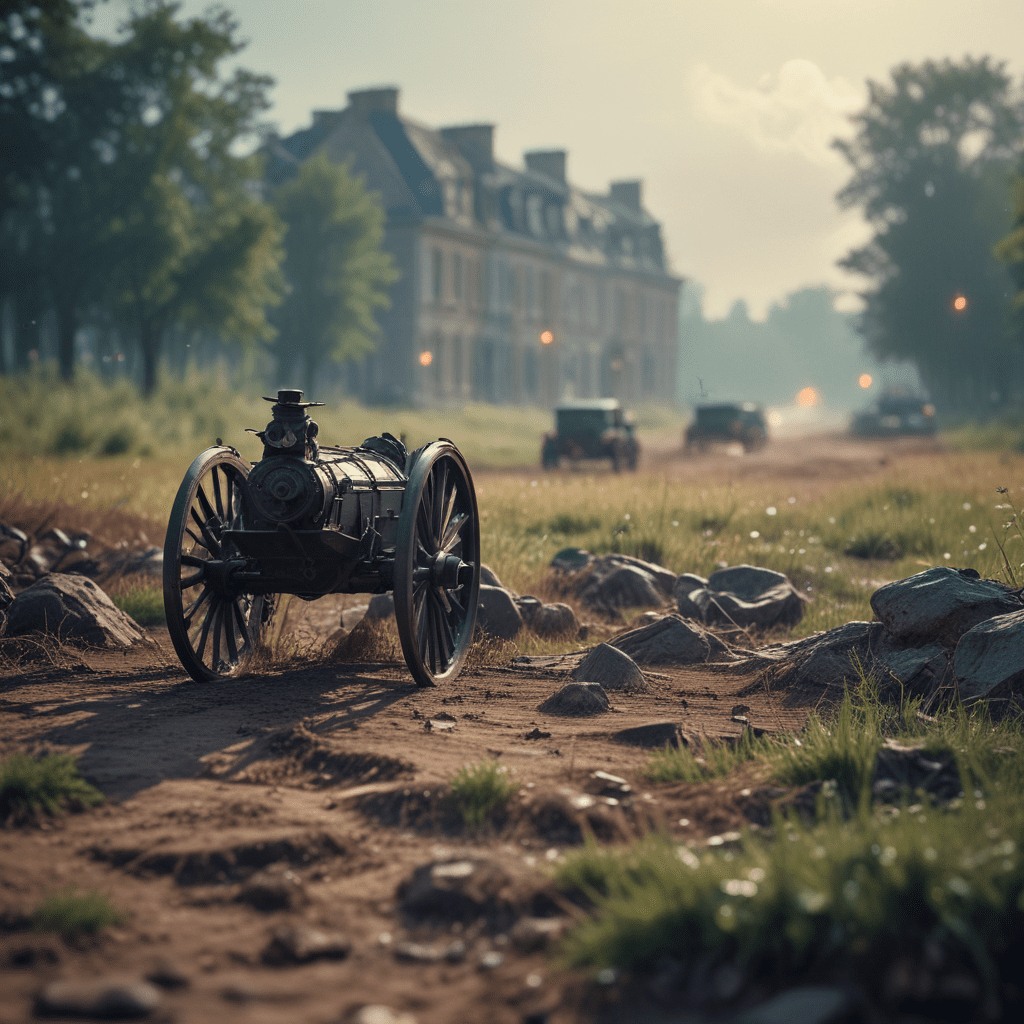Unraveling the Mysteries of Waterloo Battlefield:
1. Introduction:
The Battle of Waterloo, fought on June 18, 1815, near the village of Waterloo in present-day Belgium, is one of the most famous battles in history. The battle pitted the French army led by Napoleon Bonaparte against the armies of the Seventh Coalition, led by the Duke of Wellington and Gebhard Leberecht von Blücher. The battle resulted in a decisive victory for the Coalition, ending Napoleon's reign and ushering in a new era of European peace.
Despite its pivotal role in history, the Battle of Waterloo remains shrouded in mystery. Many unanswered questions linger about the battle's course, its causes, and its consequences. This article delves deep into the battlefield of Waterloo, uncovering its mysteries and exploring its enduring legacy.
2. The Landscape of Battle:
The battlefield of Waterloo is a relatively flat plain, punctuated by a few small hills and streams. This seemingly ordinary landscape played a crucial role in the battle's outcome. The French army, relying on its superior artillery, initially occupied the high ground, giving them a tactical advantage. However, the Coalition forces, utilizing their superior maneuverability, were able to exploit the terrain's features to their advantage. The rolling hills provided cover for their infantry, while the streams allowed them to disrupt the French cavalry charges.
The landscape also influenced the strategic decisions of the commanders. Napoleon, known for his aggressive tactics, was hampered by the difficulty of maneuvering his large army across the uneven terrain. Wellington, on the other hand, used the landscape to his advantage, creating a strong defensive position and waiting for the opportune moment to counterattack.
3. The Armies and Their Leaders:
The Battle of Waterloo was a clash of titans, featuring some of the most renowned military leaders of the era. Napoleon Bonaparte, the self-proclaimed Emperor of France, was a master of strategy and tactics, known for his lightning-fast campaigns and innovative use of artillery. The Duke of Wellington, the British commander, was a cautious but brilliant tactician, renowned for his ability to inspire his troops and exploit his opponent's weaknesses. Gebhard Leberecht von Blücher, the Prussian field marshal, was a fearless and aggressive leader, known for his relentless pursuit of the enemy.
The armies themselves were formidable forces. The French army, despite its recent setbacks, was still the largest and best-equipped army in Europe. The Coalition, though outnumbered, benefited from the combined strength of British, Prussian, Dutch, and Hanoverian troops. Each army had its strengths and weaknesses, and the outcome of the battle would hinge on the ability of their commanders to exploit these differences.
4. The Day of Battle:
The Battle of Waterloo unfolded over a long and bloody day. The morning began with a French artillery bombardment, followed by a series of infantry attacks against the Allied center. These attacks were met with stiff resistance from the British and their allies, who held their ground despite heavy casualties. In the afternoon, Napoleon, believing he had broken the Allied line, launched a massive cavalry charge. However, the charge was repulsed with heavy losses, marking a turning point in the battle.
As the day wore on, the Prussian army arrived on the battlefield, flanking the French forces and threatening their rear. Napoleon, now facing a two-front war, was forced to retreat. The Coalition forces pursued the retreating French, inflicting heavy casualties and securing a decisive victory.
5. The Legacy of Waterloo:
The Battle of Waterloo had a profound impact on European history. It ended Napoleon's reign of terror and ushered in a new era of peace and stability. The battle also marked the end of the French Empire and the beginning of a new balance of power in Europe. The legacy of Waterloo continues to resonate today, reminding us of the importance of international cooperation and the fragility of peace.
6. Uncovering the Unknown:
Despite the wealth of information available about the Battle of Waterloo, several mysteries remain unsolved. One of the most enduring enigmas is the disappearance of the French Imperial Eagle. This golden eagle, mounted atop a staff, served as the symbol of the French Empire and its presence on the battlefield boosted the morale of the French troops. During the chaotic retreat, the eagle vanished without a trace, sparking endless speculation about its fate. Some believe it was captured by Prussian soldiers, while others claim it was hidden by French loyalists. To this day, the whereabouts of the Imperial Eagle remain a mystery.
Another unsolved mystery surrounds the death of Major-General Sir William Ponsonby. Ponsonby, a British cavalry commander, was killed during the battle, but the circumstances of his death remain unclear. Some accounts claim he was shot by French soldiers, while others suggest he was trampled by his own horse. The exact location of his body was also never determined, adding to the enigma.
7. Myths and Misconceptions:
Over the years, numerous myths and misconceptions have sprung up around the Battle of Waterloo. One of the most persistent myths is that the battle was won by the Prussians, who arrived on the battlefield just as Napoleon was about to claim victory. This myth ignores the crucial role played by the British and their allies throughout the day. While the Prussian arrival undoubtedly tipped the balance in favor of the Coalition, it was the combined efforts of all the Allied forces that ultimately secured the victory.
Another misconception is that Napoleon was a reckless and impulsive leader who led his army to defeat. While Napoleon's ambition and self-confidence sometimes led him to take risks, he was also a brilliant strategist who meticulously planned his campaigns. The Battle of Waterloo was a complex event with multiple factors contributing to its outcome, and it is inaccurate to solely blame Napoleon for the French defeat.
8. The Battlefield Today:
Today, the Waterloo Battlefield is a popular tourist destination, attracting visitors from around the world. The battlefield has been meticulously preserved, with monuments, memorials, and museums commemorating the events of 1815. Visitors can walk the same ground where Napoleon and Wellington clashed, imagining the sights and sounds of the battle. The Lion's Mound, a towering artificial hill built in honor of the fallen, offers panoramic views of the battlefield. The nearby Wellington Museum houses a collection of artifacts and exhibits related to the battle.
The Waterloo Battlefield is not just a historical site; it is also a place of reflection. As visitors walk among the memorials and monuments, they are reminded of the human cost of war and the importance of striving for peace.
9. Future Research and Discoveries:
The Battle of Waterloo continues to fascinate historians and researchers. New discoveries and insights are still being made about the battle, shedding light on its complexities and nuances. Archaeological excavations have uncovered new artifacts and remains, providing valuable clues about the lives of the soldiers who fought and died on that fateful day. Historians continue to debate the decisions made by the commanders, the effectiveness of different strategies, and the role of chance in determining the outcome.
Future research on the Battle of Waterloo could focus on several areas. One avenue is exploring the social and economic impact of the battle on the communities that lived near the battlefield. Another area is investigating the long-term political and diplomatic consequences of the battle for Europe. Additionally, researchers could delve deeper into the individual experiences of the soldiers who fought in the battle, using letters, diaries, and other primary sources to reconstruct their stories.
The Battle of Waterloo remains a rich and fertile ground for research and discovery. As new evidence and perspectives emerge, our understanding of this pivotal event in history will continue to evolve.
FAQ:
Q: What was the main cause of the Battle of Waterloo?
A: The main cause of the Battle of Waterloo was Napoleon's return from exile on the island of Elba in 1815. This sparked fear among the European powers, who formed the Seventh Coalition to defeat him once and for all.
Q: Who was the commander of the French army at Waterloo?
A: Napoleon Bonaparte was the commander of the French army at Waterloo.
Q: Who were the commanders of the Coalition forces at Waterloo?
A: The commanders of the Coalition forces were the Duke of Wellington and Gebhard Leberecht von Blücher.
Q: What was the outcome of the Battle of Waterloo?
A: The Battle of Waterloo resulted in a decisive victory for the Coalition forces, leading to the end of Napoleon's reign and the ushering in of a new era of European peace.



